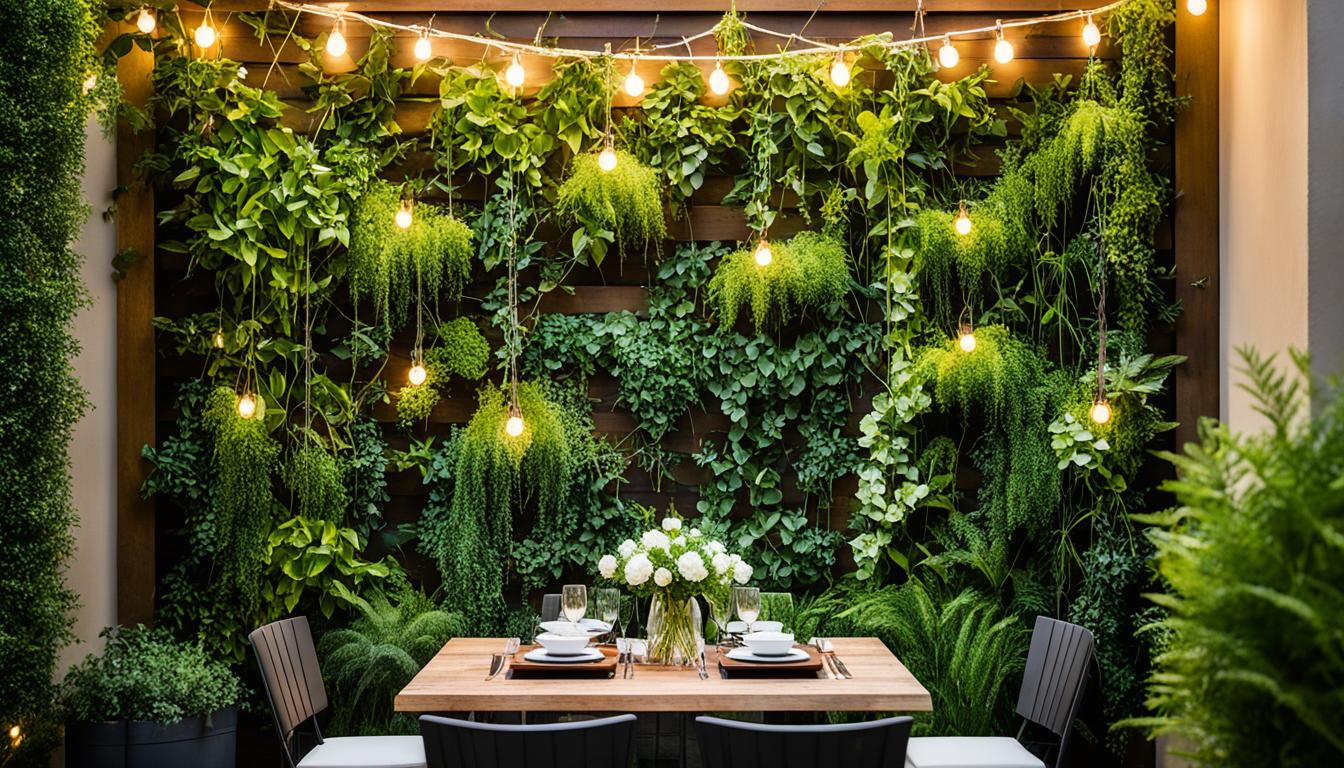I’m excited to share some creative and sustainable gardening solutions that will help you transform your small backyard into a lush and vibrant oasis. With urban gardening on the rise, maximizing space has become more important than ever. Vertical gardening is the perfect solution for small yards and backyards, allowing you to make the most of your outdoor living area while adding beauty and greenery.
By repurposing your space and thinking creatively, you can create stunning DIY vertical gardens that are both functional and aesthetically pleasing. These vertical gardening ideas will not only maximize your small backyard but also promote sustainable gardening practices.
Key Takeaways:
- Vertical gardening is a great way to maximize space in small backyards.
- Urban gardening is on the rise and offers opportunities for creative gardening solutions.
- DIY vertical gardens can add vibrancy and beauty to outdoor living areas.
- Sustainable gardening practices can be incorporated into vertical gardening.
- Small space gardening ideas can transform even the tiniest outdoor areas into thriving oases.
Trellises for Vining Plants
Trellises are an essential element in vertical garden design, providing support for climbing plants and maximizing small space gardening. These frames can be attached to exterior walls or left freestanding, allowing vining plants to grow upward and create a lush, green backdrop in your garden. By planting vines at the base of the trellis and training them to weave through the mesh, you can create a beautiful and functional vertical garden.
There are various advantages to incorporating trellises in your vertical garden design. Firstly, trellises maximize garden space by utilizing vertical surfaces, making them particularly beneficial for small backyards or urban gardens with limited space. By growing plants vertically, you can effectively increase the amount of greenery and foliage in your garden, even in small areas.
Trellises also promote the growth of high-quality fruits and vegetables. By training vining plants, such as tomatoes, cucumbers, and melons, to grow upward, you can ensure proper airflow and sunlight exposure, which leads to healthier and more productive plants. Additionally, trellises make it easier to monitor and harvest your crops, allowing for convenient accessibility regardless of age or mobility.
Another advantage of using trellises is their ability to prevent pest and disease problems. By keeping climbing plants off the ground, trellises help to minimize contact with soil-borne pathogens and pests, reducing the likelihood of plant diseases and infestations. This can contribute to healthier plants and higher yields.
The cost of trellises can vary depending on the material used and the desired size. Typically, trellises range from $50 to $135 per linear foot. It’s important to consider the durability and strength of the material when selecting a trellis, as it needs to withstand the weight and growth of climbing plants over time.
When it comes to selecting vining plants for trellises, there is a wide range of options to choose from. Popular choices include Blackberries, Grapes, Raspberries, Clematis, Honeysuckle, Morning Glories, Nasturtium, Passion Flower, Star Jasmine, Cucumbers, Melons, and Pole Beans. These plants thrive in a vertical garden setting and will add beauty and functionality to your space.
Incorporating trellises into your vertical garden design is a practical and aesthetically pleasing way to maximize your small space. Whether you’re growing fruits, vegetables, or ornamental plants, trellises provide support, increase accessibility, and enhance the overall appearance of your garden.
Green Walls of Container Plants
Green walls, also known as living walls, are a fantastic way to create vertical gardens in small spaces. By affixing pots or wall planters to various surfaces such as fencing or exterior walls, you can transform your small space into a lush oasis.
Container plants are the key to creating green walls. They are easy to set up and maintain, making them an ideal choice for DIY enthusiasts. With container plants, you have the flexibility to grow a wide variety of plants, including flowers, herbs, vegetables, and succulents.
To get started with your own DIY living wall, you can either buy a ready-made wall system or build your own. The cost of a living wall can range from $30 to $80, excluding plants, depending on the option you choose.
Recommended plants for container gardens:
- Citrus fruits
- Figs
- Alpine strawberries
- Coleus
- Geraniums
- Phlox
- Basil
- Cilantro
- Rosemary
- Broccoli
- Eggplant
- Tomatoes
With a green wall of container plants, you can add beauty, interest, and fresh aromas to your small space. Whether you have a balcony, patio, or small backyard, this vertical gardening technique is sure to make a significant impact.
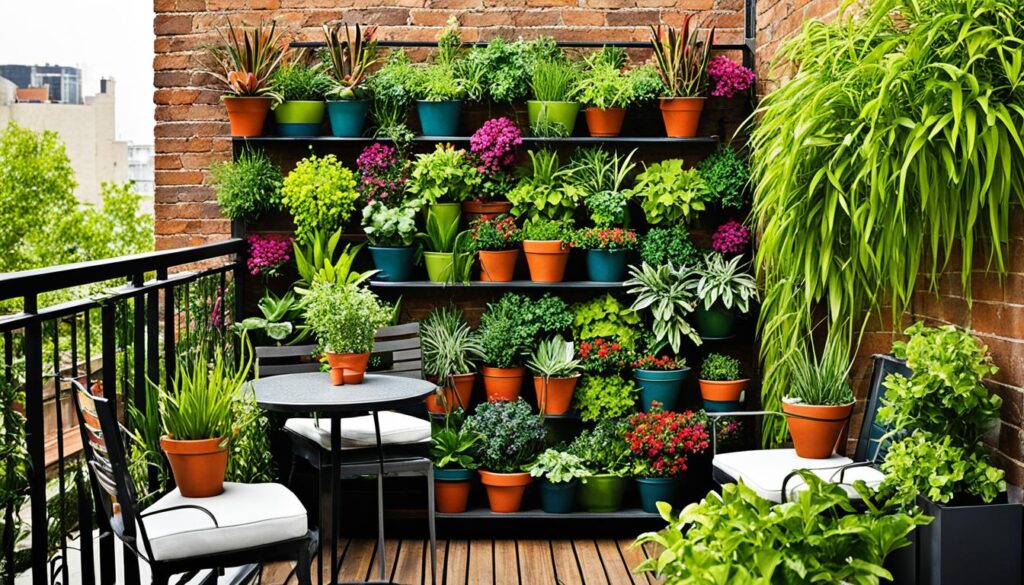
Advantages of Green Walls
Green walls offer several advantages for small space gardening:
- Maximize Space: Green walls allow you to utilize vertical surfaces, making the most of your small space.
- Improved Air Quality: Plants on green walls help purify the air by removing pollutants and releasing oxygen.
- Enhanced Aesthetics: The lush greenery of a living wall adds a visually appealing element to your small space.
- No Soil Erosion: Green walls help prevent soil erosion, especially in areas with limited ground space.
- Easy Maintenance: Container plants are generally low maintenance, requiring less effort than traditional gardens.
Whether you’re a gardening enthusiast or a beginner, green walls of container plants offer a versatile and beautiful solution for small space gardening. Start your vertical garden project today and enjoy the benefits of a vibrant and thriving living wall.
| Advantages | |
|---|---|
| Maximize Space | ✔ |
| Improved Air Quality | ✔ |
| Enhanced Aesthetics | ✔ |
| No Soil Erosion | ✔ |
| Easy Maintenance | ✔ |
Hydroponic Living Walls
Hydroponic living walls are revolutionizing vertical gardening by offering a unique and innovative way to grow plants. Unlike traditional gardening methods that use soil, hydroponic gardens utilize nutrient-rich water to nourish the plants. This sustainable gardening technique is especially beneficial for small space gardening, as it allows plants to thrive in compact areas.
One of the key advantages of hydroponic living walls is their versatility in design. They can be created using various structures such as pipes, towers, or gutters, making them adaptable to different spaces and preferences. Whether you have a small balcony or a limited backyard, hydroponic living walls offer a solution that maximizes vertical space while creating a stunning green display.
Hydroponic living walls offer numerous benefits beyond their space-saving design. By growing plants without soil, these walls provide a more efficient use of resources and minimize the risk of soil-borne diseases. Furthermore, the absence of soil also means less weeding and maintenance, making hydroponic gardens easier to manage.
Another advantage of hydroponic living walls is their positive impact on the environment and sustainability. These walls enhance property value by adding a unique and visually appealing feature. Additionally, they improve air quality by absorbing carbon dioxide and releasing oxygen, creating a healthier living environment. Their shade and insulation properties can also help reduce energy bills.
The cost of building a hydroponic living wall varies depending on factors such as size, difficulty, and plant selection. On average, the cost ranges from $500 to $2,000. However, the initial investment is offset by the long-term savings in water usage, maintenance, and the opportunity to grow fresh produce at home.
Recommended plants for hydroponic living walls include a variety of fruits, vegetables, and flowering plants. From juicy currants and strawberries to vibrant impatiens and petunias, hydroponic gardens offer endless possibilities for plant selection. These walls also provide an ideal environment for cultivating herbs like chives, parsley, and sage, alongside fresh greens like lettuce and spinach.
Experience the beauty and functionality of hydroponic living walls in your small space garden. Create a DIY hydroponic garden or explore ready-made options to transform your vertical space into a flourishing oasis.
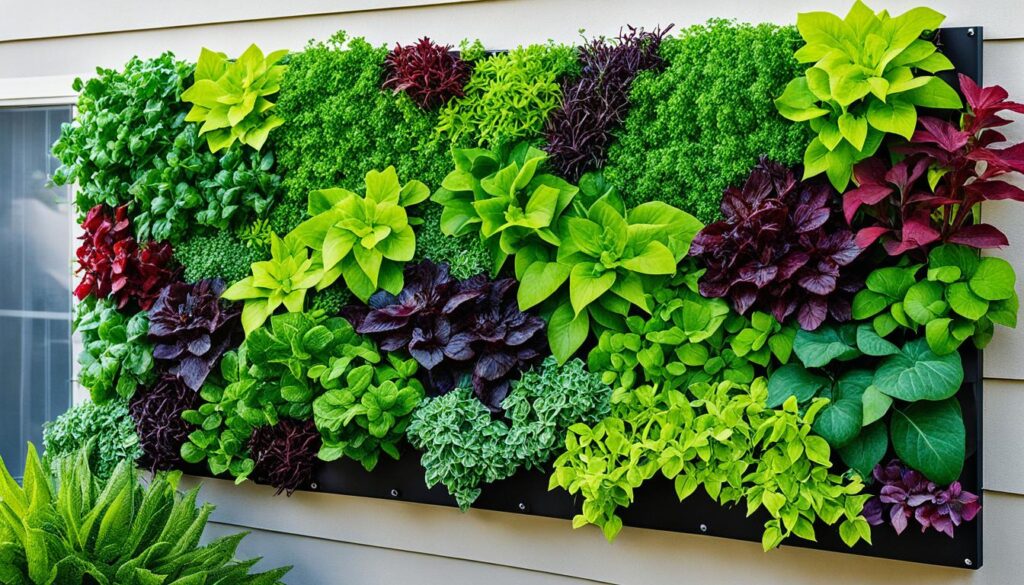
Benefits of Hydroponic Living Walls:
- Maximizes vertical space in small gardens
- Efficient use of resources
- Reduced risk of soil-borne diseases
- Minimal maintenance and weeding
- Enhances property value
- Improves air quality
- Reduces energy bills
Recommended Plants for Hydroponic Living Walls:
| Fruits | Vegetables | Flowering Plants | Herbs | Leafy Greens |
|---|---|---|---|---|
| Currants | Bell Peppers | Impatiens | Chives | Lettuce |
| Strawberries | Watermelons | Petunias | Parsley | Spinach |
Pallet Planters for Herbs and More
If you enjoy upcycling and want to add some greenery to your small space, pallet planters are an excellent choice. These DIY garden projects can be built using old pallets and are perfect for growing herbs and other small plants in a small area. Pallets are budget-friendly and easy to assemble, making them a popular choice for small space gardening enthusiasts.
Once you have your pallet planter constructed, it’s important to ensure proper maintenance for the health and growth of your plants. This includes regular watering, trimming, and pest management. With the right care, your pallet planter garden can thrive and bring beauty to your small space.
Recommended Plants for Pallet Planters
- Strawberries
- Begonias
- Petunias
- Succulents
- Oregano
- Parsley
- Peppermint
- Arugula
- Cherry tomatoes
- Summer squash
These plants are well-suited for pallet planters and can thrive in a small space. From delicious herbs to colorful flowers, you can create a diverse and vibrant garden using pallet planters.
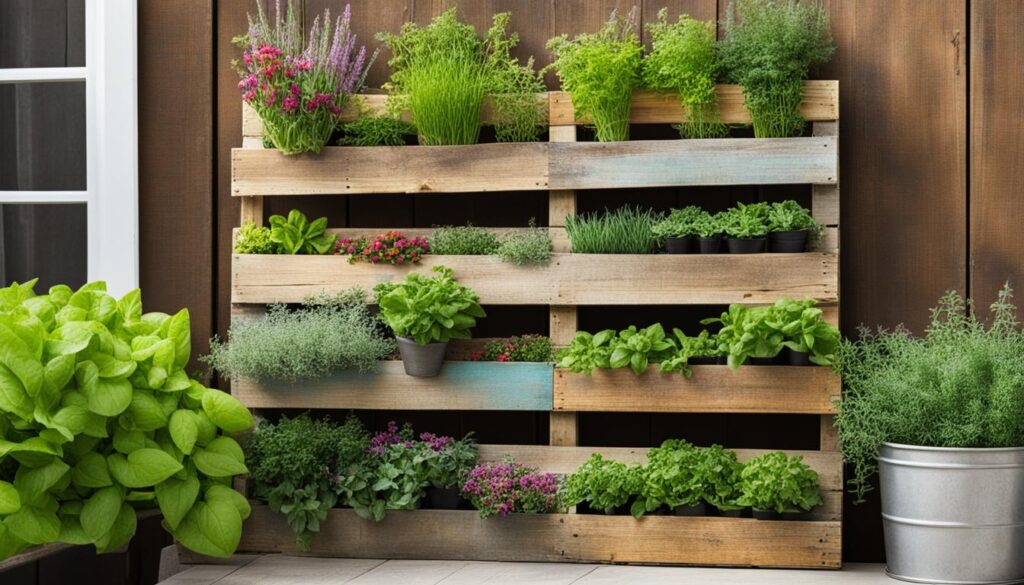
| Cost Range | Supplies Needed |
|---|---|
| $50 – $200 | Old pallets, soil, plants, nails or screws, gardening tools |
The cost of creating a pallet planter garden can vary depending on the supplies you need. However, it remains an affordable option for small space gardening.
By repurposing old pallets and getting creative with your vertical garden design, you can turn even the smallest of spaces into a thriving garden oasis. Pallet planters offer a cost-effective and sustainable solution for those who want to add some greenery to their small space.
Build a Gutter Garden
A gutter garden is a unique and space-saving way to grow plants vertically. By repurposing old gutters or PVC pipes, you can create these gardens and mount them on fences, trellises, walls, or deck railings. This DIY garden project is perfect for small spaces like balconies and apartments, allowing you to maximize every inch of your outdoor area.
Gutter gardens are not only practical but also aesthetic, adding a touch of greenery to any space. They are easy to maintain, providing excellent drainage for your plants. Whether you choose to purchase new gutters or use repurposed ones, the cost of a gutter garden can be affordable and budget-friendly.
Recommended plants for gutter gardens include flowers to add color and beauty, herbs to enhance your culinary endeavors, vegetables to grow your own produce, and air plants for unique and low-maintenance decor.
| Advantages of a Gutter Garden | Disadvantages of a Gutter Garden |
|---|---|
|
|
Trellises and Arbors
Trellises and arbors are timeless and widely used methods for supporting climbing plants in vertical gardens. They offer numerous benefits, including the creation of privacy barriers, enhancing the beauty of outdoor spaces, and providing a support system for a variety of plants such as roses, jasmine, and various fruits and vegetables. Trellises and arbors can be customized to fit any space, making them a versatile option for small space gardening. Whether you opt for a DIY project or purchase a pre-made trellis or arbor, these structures are not only functional but also add aesthetic appeal to your garden.
One of the significant advantages of utilizing trellises and arbors is their ability to prevent soil erosion. By providing vertical support, these structures effectively retain the soil, reducing the risk of erosion due to heavy rain or wind. Additionally, these vertical structures improve air circulation around the plants, promoting healthier growth and reducing the likelihood of fungal diseases.
If you choose to incorporate trellises or arbors into your vertical garden, consider the specific climbing plants you want to grow. Different plants have varying needs when it comes to support systems. Some plants may require a sturdier trellis or arbor, while others can thrive on lighter structures. Research the specific requirements of your chosen plants to ensure optimal growth and support.
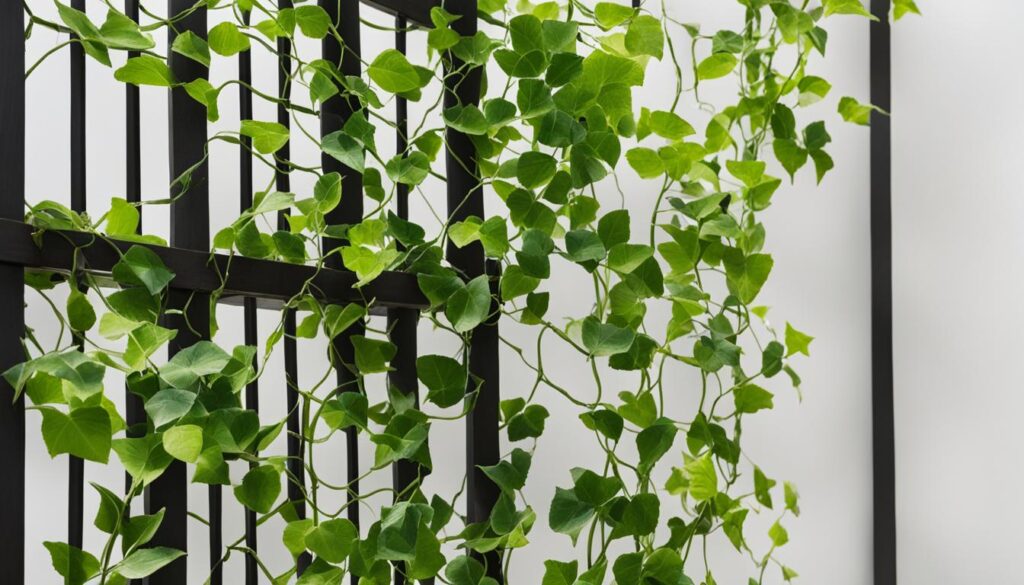
Using trellises and arbors also allows for creativity in your gardening endeavors. You can train vines to grow in specific patterns, creating beautiful designs on your vertical structures. This adds a unique touch to your outdoor space, making it a visually appealing and inviting area to spend time in.
If you’re planning to build your own trellis or arbor, there are various materials you can use, including wood, metal, and PVC. Each material offers different benefits in terms of durability, aesthetics, and cost. Consider your budget, skill level, and desired style when choosing the materials for your DIY project.
In conclusion, trellises and arbors are classic choices for supporting climbing plants in vertical gardens. They serve multiple purposes, from creating privacy to enhancing the beauty of your outdoor space. Whether you opt for a DIY project or a ready-made structure, trellises and arbors provide both functional and aesthetic benefits for small space gardening.
Stackable Planters
When it comes to vertical gardening in small spaces, stackable planters are a game-changer. These versatile and movable planters offer a practical solution for maximizing your gardening area while utilizing resources efficiently. With stackable planters, you can create a thriving garden filled with herbs, vegetables, and flowers, even if you have limited space.
One of the key advantages of stackable planters is their ease of assembly. You can quickly set them up and rearrange them as needed to optimize sunlight exposure for each plant. This mobility ensures that all your plants receive the vital rays they need to thrive.
Stackable planters are not only suitable for those with limited outdoor space but also for individuals with restricted mobility. Since they can be placed on a tabletop or raised platform, they eliminate the need for bending or kneeling, providing a more accessible gardening experience for everyone.
The cost of stackable planters varies depending on the materials and size you choose. Whether you opt for plastic, ceramic, or recycled materials, stackable planters offer an affordable and sustainable solution for a DIY garden project.
Conclusion
As I conclude this article, I want to emphasize the incredible potential of vertical gardening for small backyards, urban spaces, and any area with limited room. By embracing vertical structures and implementing creative techniques, you can transform your compact outdoor space into a vibrant and flourishing garden. Whether you opt for trellises, green walls, hydroponics, pallet planters, gutter gardens, or stackable planters, the possibilities for vertical gardening are endless.
Vertical gardening not only maximizes the use of space but also promotes sustainable practices and provides innovative solutions for small space gardening. With DIY vertical gardens, you have the freedom to customize and design according to your taste and preferences, making your garden uniquely yours. Let your creativity blossom and explore the world of vertical gardening to create an inspiring and green oasis right in your own backyard.
I hope that this article has inspired you with a host of ideas and possibilities for your small space gardening project. Remember, with vertical gardening, your creativity knows no bounds. So, it’s time to get your hands dirty, embrace sustainability, and enjoy the beauty and abundance of your vertical garden.
FAQ
What is vertical gardening?
Vertical gardening is a technique that utilizes vertical space to grow plants, maximizing small outdoor areas such as small backyards, balconies, and patios.
What are trellises?
Trellises are frames used to support the growth of climbing plants. They can be affixed to exterior walls or left freestanding to lean against another structure.
What plants are suitable for trellises?
Recommended vining plants for trellises include blackberries, grapes, raspberries, clematis, honeysuckle, morning glories, nasturtium, passion flower, star jasmine, cucumbers, melons, and pole beans.
What are green walls?
Green walls, also known as living walls, are created by affixing pots or wall planters to various surfaces. They allow you to grow a wide variety of plants, including flowers, herbs, vegetables, and succulents.
What plants are suitable for green walls?
Recommended plants for container gardens include citrus fruits, figs, alpine strawberries, coleus, geraniums, phlox, basil, cilantro, rosemary, broccoli, eggplant, and tomatoes.
What are hydroponic living walls?
Hydroponic living walls are a unique form of vertical gardening where plants are grown using nutrient-rich water instead of soil. They can be built using pipes, towers, or gutters.
What plants are suitable for hydroponic living walls?
Recommended plants for hydroponic walls include currants, strawberries, watermelons, impatiens, petunias, wallflowers, chives, parsley, sage, bell peppers, lettuce, and spinach.
What are pallet planters?
Pallet planters are planters made using old pallets. They are perfect for growing herbs and other small plants in a small space.
What plants are suitable for pallet planters?
Recommended plants for pallet planters include strawberries, begonias, petunias, succulents, oregano, parsley, peppermint, arugula, cherry tomatoes, and summer squash.
What is a gutter garden?
A gutter garden is a space-saving way to grow plants vertically using repurposed gutters or PVC pipes. They can be mounted on fences, trellises, walls, or deck railings.
What plants are suitable for gutter gardens?
Gutter gardens can be used to grow flowers, herbs, vegetables, and air plants.
What are trellises and arbors used for?
Trellises and arbors are traditional ways to support climbing plants in a vertical garden. They can be used to create privacy barriers, enhance outdoor spaces, and grow a variety of plants.
What are stackable planters?
Stackable planters are a movable option for vertical gardening. They allow you to grow a garden in a small area and can be rotated to ensure each plant gets enough sunlight.

